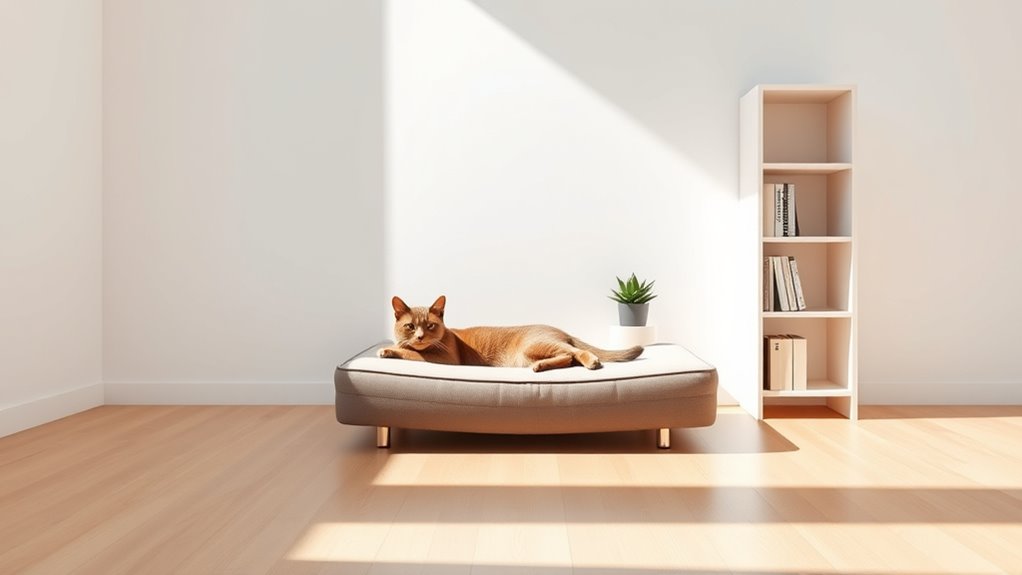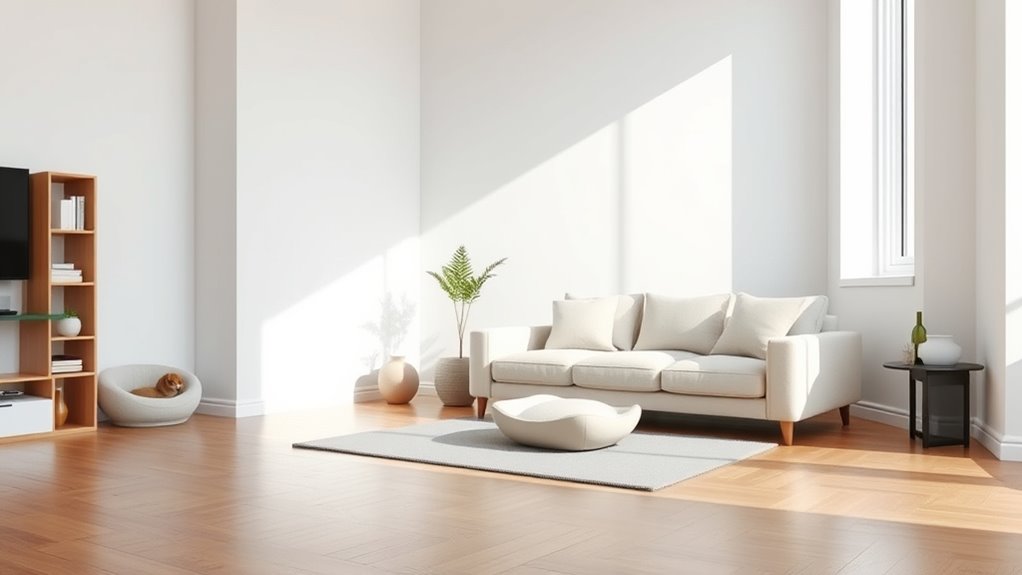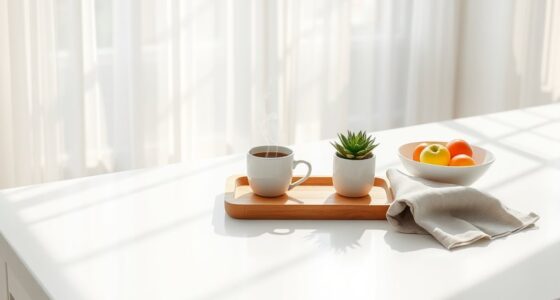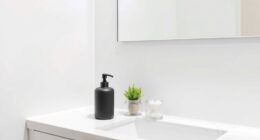To create an efficient, minimalist space for your pet, focus on decluttering and only keeping essentials like a cozy bed, toys, and grooming supplies. Choose furniture with clean, simple lines made from eco-friendly materials, and designate specific zones for eating and playing. Incorporate natural light and non-toxic plants for a healthier environment. Keeping things streamlined reduces stress and fosters harmony. Explore more ways to design a pet-friendly, eco-conscious home that benefits both of you.
Key Takeaways
- Prioritize essential pet items and use multi-purpose furniture to reduce clutter and optimize space.
- Choose eco-friendly, non-toxic materials for furniture and decor to ensure a safe, healthy environment.
- Designate specific zones for eating, sleeping, and playing to maintain organization and accessibility.
- Incorporate natural light and ventilation to enhance comfort and promote a calming atmosphere.
- Keep sharp or breakable objects out of pet reach and select furniture with rounded edges for safety.

Many pet owners are embracing minimalism to create a calmer, clutter-free environment that benefits both people and animals. By simplifying your space, you reduce stress and make it easier to care for your pet. One key aspect of minimalist pet-friendly design is using eco-friendly materials. These materials are not only better for the environment but also safer for your animals. Think about furniture made from reclaimed wood or sustainable bamboo, which are durable and non-toxic. Avoid plastics or synthetic fabrics that can emit harmful chemicals, especially in areas your pet frequents. Incorporating natural, eco-friendly materials helps create a healthier environment for everyone in the household.
When designing a minimalist space for your pet, focus on functionality without excess. Keep only what you need, like a cozy bed, a few toys, and essential grooming supplies. Select furnishings with clean lines and simple shapes that blend seamlessly into your home. Opt for pet beds made from natural fabrics and eco-conscious filling to guarantee comfort without compromising on sustainability. Choose multi-purpose furniture, like storage ottomans or benches, that can hide away toys and supplies, reducing visual clutter. This approach not only keeps your space tidy but also encourages your pet to relax in an organized environment.
A crucial component of pet-friendly design is ensuring safety and comfort. Use non-toxic, eco-friendly paints and finishes on walls and furniture to prevent exposure to harmful chemicals. Create designated zones for eating, sleeping, and playing that are easily accessible but free from hazards. Keep sharp or breakable objects out of reach and choose furniture with rounded edges to prevent injuries. Incorporate natural light and good ventilation, which are vital for a healthy, inviting space. Plants can add freshness, but make sure they’re non-toxic and safe for pets, avoiding any that might be poisonous. Additionally, understanding the benefits of eco-friendly materials can help you select sustainable options that enhance your pet’s environment.
Minimalism isn’t just about aesthetics; it’s about creating an efficient space tailored to your pet’s needs. Streamline your belongings, prioritize quality over quantity, and choose eco-friendly, pet-safe materials. Doing so results in a calming environment that reduces stress for both you and your pet. By adopting a minimalist, eco-conscious approach, you foster a harmonious home where your animal companion feels secure and comfortable. This thoughtful design promotes a peaceful, clutter-free lifestyle that benefits everyone involved, making daily routines simpler and more enjoyable.
Frequently Asked Questions
How Can Minimalism Reduce Pet-Related Clutter Effectively?
You can reduce pet-related clutter by streamlining supplies and dedicated spaces. Use a minimal pet enclosure that’s easy to clean and fits your space, and keep grooming stations organized with only essential tools. Regularly declutter items like toys and bedding, choosing multi-purpose pieces to save space. This approach keeps your home tidy, making it easier to maintain a functional, minimal environment for your pet and yourself.
What Are Space-Saving Furniture Options for Pet Areas?
Imagine transforming your pet space effortlessly—you’ll want to explore folding furniture and modular storage options. Folding beds and tables tuck away when not in use, freeing up precious space. Modular storage helps you organize toys, leashes, and supplies neatly, creating a clutter-free environment. These innovative pieces are perfect for maximizing small areas, making your pet’s space both functional and sleek. Ready to upgrade your pet zone? The solution’s in smart, space-saving furniture.
How to Incorporate Pet Needs Into Minimalist Design?
To incorporate pet needs into minimalist design, choose pet-friendly materials like natural wood or silicone that are durable and easy to clean. Create a cozy corner design with a sleek bed or hammock that blends seamlessly into your space, maintaining clean lines. Keep clutter minimal by integrating storage solutions and using multi-functional furniture, ensuring your pet’s comfort without sacrificing your minimalist aesthetic.
What Safety Considerations Are Essential in Minimalist Pet Spaces?
You should prioritize hazard prevention by removing sharp objects and choking hazards. Choose safe material selection, avoiding toxic paints, plastics, or fabrics that could harm your pet. confirm that furniture and fixtures are stable to prevent tipping, and keep cords and small items out of reach. Regularly inspect your space for potential dangers, making it a secure environment where your pet can play and relax safely without risk.
How to Maintain Cleanliness With Minimalist Pet Accessories?
Ever notice how a simple wipe keeps your space spotless? To maintain cleanliness with minimalist pet accessories, regularly clean feeding stations and groom your pet to prevent dirt buildup. Use easily washable materials like stainless steel or ceramic for bowls, and keep grooming tools organized and sanitized. This way, your space stays sleek, hygienic, and clutter-free, giving your pet a clean environment without sacrificing style or functionality.
Conclusion
By embracing minimalism, you create a calmer, more functional space for your pet, reducing stress and clutter. Did you know that a cluttered environment can increase anxiety in animals? Simplifying your home not only benefits you but also enhances your pet’s well-being. Keep only what truly matters, and you’ll foster a peaceful environment where your furry friend can thrive. Minimalism isn’t just stylish—it’s a caring choice for your animal companion.








